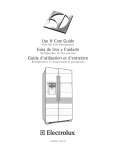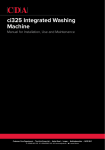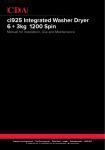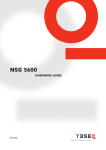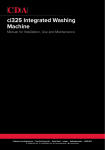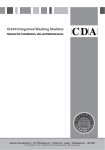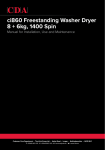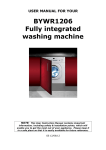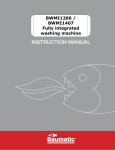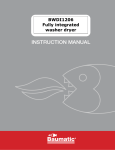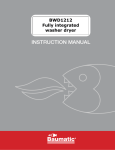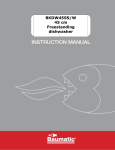Download CDA CI260
Transcript
CI260 freestanding washing machine Manual for Installation, Use and Maintenance Customer Care Department • The Group Ltd. • Harby Road • Langar • Nottinghamshire • NG13 9HY T : 01949 862 012 F : 01949 862 003 E : [email protected] W : www.cda.eu 2 Contents page page 4 Important page 6 Safety warnings page 7 Warning page 8 Recommendations page 9 Before first use Page 11 Detergents and additives Page 12 Eco note Loading the washing machine Page 13 Control panel Page 14 Starting a wash programme Page 18 Wash programme phases and power cuts Page 19 Programme table Page 22 Care and maintenance Page 23 Pump filter Page 24 Detergent drawer Page 25 Cleaning the washing machine exterior The drum Limescale removal Page 26 Practical information Page 28 Installation Page 29 Levelling Page 30 Connecting to the mains water supply Drainage connection Page 31 Electrical information Page 32 Technical specifications Page 33 Failure codes and troubleshooting Troubleshooting Page 36 International washing signs 3 Important This appliance must only be used for the purpose for which it is intended, i.e. domestic use. Any other use could be dangerous and may lead to premature failure of the appliance. The CDA Group Ltd cannot be held responsible for injuries or losses caused by incorrect use or installation of this product. Please note that CDA reserve the right to invalidate the guarantee supplied with this product following incorrect installation or misuse of the appliance. Under no circumstances should any external covers be removed for servicing or maintenance except by suitably qualified personnel. Appliance information: Please enter the details on the appliance rating plate below for reference, to assist CDA Customer Care in the event of a fault with your appliance and to register your appliance for guarantee purposes. Appliance Model Serial Number CE Declarations of Conformity: This appliance has been designed, constructed and marketed in compliance with safety requirements of EEC Directive 2006/95/EEC (Low voltage) and requirements of EMC Directive 2004/108/EEC. 4 IMPORTANT INFORMATION FOR CORRECT DISPOSAL OF THE PRODUCT IN ACCORDANCE WITH EC DIRECTIVE 2002/96/EC. At the end of its working life, the product must not be disposed of as urban waste. It must be taken to a special local authority differentiated waste collection centre or to a dealer providing this service. Disposing of a household appliance separately avoids possible negative consequences for the environment and health deriving from inappropriate disposal and enables the constituent materials to be recovered to obtain significant savings in energy and resources. As a reminder of the need to dispose of household appliances separately, the product is marked with a crossed-out wheeled dustbin. 5 Safety warnings • If the plug or cord are damaged, do not connect the appliance to the mains power supply. If the cord is damaged it should be replaced by the manufacturer or appointed service agent in order to avoid a hazard. • To remove the plug from the socket, pull on the body of the plug, not the cable. • Do not plug the appliance in to the mains power supply with wet or damp hands. • Never touch the appliance with wet hands or feet. • Never open the detergent drawer when a programme is running. • Never force the appliance door open when a programme is running. • Since the appliance can reach high temperatures while running, do not touch the drain hose or drained water during draining. • In case of any failure, first unplug the appliance and close the water tap. • Repair on this appliance should only be undertaken by suitably qualified personnel. • Keep the packing materials away from children to prevent risk of injury. • Do not let children play with the washing machine. • Keep pets away from the appliance. • The appliance should not be installed on carpeted surfaces as this can block the air ventilation on the base. 6 Warnings To avoid the risk of fire, electric shocks, injury or damage when using your washing machine, please take the following precautions: • Please read all the instructions before using the washing machine. • Do not wash items that have previously been cleaned, washed, soaked or treated with petrol, solvents for dry cleaning, other inflammable substances or explosives, as they produce fumes that could catch fire or explode. • Do not add petrol, solvents for dry cleaning or other inflammable or explosive substances to the wash water as they produce fumes that could catch fire or explode. • Do not repair or replace any part of the washing machine or try to carry out any type of servicing unless it is recommended in the maintenance instructions in the manual. • Do not climb onto the machine or stand on the open porthole door. • Do not use an extension lead or adaptor to connect your washing machine to the mains supply. • Follow the washing instructions recommended by the manufacturer of the garment to be washed. • Do not turn your washing machine on until you are sure that: It has been installed in accordance with the installation instructions. All the water, drainage, mains electricity and earth connections meet the local regulations and/or other applicable regulations. Important: Ensure that the transit bolts have been removed prior to using the machine. 7 Recommendations • Residues of detergent or softener left in the detergent drawer for long periods will dry and stick to the detergent drawer. To prevent this put the detergent and softener into the detergent drawer just before washing. • It is recommended that the pre-wash programme should only be used for very dirty clothes. • Do not exceed the maximum loading capacity. • When the machine is not in use, keep the water tap closed. • The appliance is not intended for use by people (including children) with reduced physical, sensory or mental capabilities, or lack of experience and knowledge, unless they have been given supervision or instruction concerning use of the appliance by a person responsible for their safety. Children should be supervised to ensure that they do not play with the appliance. • If the appliance is not to be used for prolonged periods of time, unplug the appliance, close the water tap and leave the door ajar to keep the inside of the machine dry and to prevent unpleasant odours from developing. • As a result of the quality control procedures during production, a certain amount of water may remain in the appliance. This is normal and does not signify a fault. • Do not remove the rating plate. The information on it is important. • This appliance should not be installed in locations where the ambient temperature may fall below 0°C. Use in ambient temperatures below 0°C may damage the machine. 8 Before first use When your washing machine has been correctly installed, we recommend that you pre-clean the machine. This is to check that the installation, the connections and the drainage are all correct, and to thoroughly clean the inside of the washing machine before any wash programmes are run. rior to pre-cleaning you should ensure the transit bolts have been P removed. • Select the Cotton 95ºC programme and add a normal dose of detergent into the detergent dispenser. • Press the Start/Pause button. Preparing Garments for Washing • Wash lightly soiled garments using a short programme. • Use a programme without prewash for medium-soiled garments. • Wash heavily soiled garments using a long programme with prewash. • Wash white and coloured loads separately. • We recommend that small garments are placed in a wash bag. • We recommend using the delicate programmes for sensitive fabrics • Separate clothes according to their types (cotton, synthetic, sensitive, woollen, etc.), required washing temperatures and level of dirtiness. • Since new coloured clothes may shed dye on the first wash, wash them separately. 9 • Remove any metal pieces found on the items to be washed, for example curtain hooks. • Fasten all zips and buttons. • Turn garments, such as knitted fabrics, inside out. • Before placing the clothes in the drum, make sure all the pockets are empty. Any small objects may block the drain pump. • We recommend loading the washing machine to its full capacity for best water and energy efficiency. • Whenever possible, we recommend that you wash garments of different sizes within the same wash programme. This improves the washing action and also aids the correct distribution of the garments in the drum when spin-drying, and the washing machine will therefore be quieter. 10 Detergents and additives Your washing machine’s detergent dispenser has three sections as shown in figure 1. Add the required amount of detergent and fabric softener into the specific sections of the detergent dispenser before starting the wash programme. The detergent dispenser is designed to allow the use of liquid detergents rather than adding them to the drum. You should ensure that you insert the liquid detergent level plate supplied in the detergent section before adding the liquid detergent. 1 Detergent 2 Fabric softener 3 Prewash detergent 1 2 3 fig. 1 To use powder detergents again, then lift the blue tab back up and relocate it by pushing it back into the dispenser housing. For washloads that require pre-washing, add ¼ of the required detergent into the prewash section, and the remainder to the detergent section. 11 Do not exceed the MAX level in the fabric softener section and ensure that concentrated fabric softeners are diluted before use for best washing results. Remember that the amount of detergent to be used will always depend on: • The amount of clothes to be washed. • How heavily the clothes are soiled. • The hardness of the water (Information on water hardness in your area can be obtained from your local water board). We recommend the use of a decalcifying product if the water hardness is high in your area. Eco Note The use of more detergent than necessary will not improve your washing results, and will have a negative effect on the preservation of the environment. We therefore recommend you follow the detergent manufacturer’s instructions. Loading the washing machine - Open the door. - Add the items to be washed separately, ensuring they are loaded evenly. - When closing the door, ensure that no item is trapped between the door and the door seal. - Close the door securely, otherwise the programme will not start. 12 Control panel 1 2 mode 0 3 ˚C 4 pre A 0 B C 400 60˚C 500 D L 40˚C 1200 J F H 8 hold extra 600 E K I 5 select 1000 G 6 1. Mode button 2. Display 3. Mode selection button 4. Wash progress indicators 700 800 easy 7 5. Start/pause button 6. Programme control knob 7. Spin speed control knob 8. Extra function buttons CI260 fig. 2 13 Starting a wash programme • Turn the programme control knob to the required programme • Turn the spin speed control knob to the required spin speed • Select any required extra functions, as detailed below • Select any required extra options, as detailed below • Press the Start/Pause button When a wash programme is in progress, the programme can be paused by pressing the Start/Pause button at any time. The programme will pause and the Start/Pause button light and progress indicator will flash. To restart the programme, press the Start/Pause button again. For added safety, the porthole door does not open immediately at the end of programme. There is a time delay of approximately two minutes before you can open the door. Programme selection To select a programme, turn the programme control knob to the required programme, as detailed in the programme table below and also on the detergent dispenser. The display will show the programme time, and the progress indicator will flash for the first section of the programme. Spin speed selection Each selected programme has its own preset spin speed, as shown in the programme table below. You can reduce the spin speed or switch it off completely if required by turning the spin speed control knob. 14 A programme without final spin is used to prevent creasing when washing special fabrics. Extra functions Extra functions can be selected once the programme has been set. To select any extra function, press the required extra function button. The programme table on page 19 shows the functions available for each programme. If the function is available, the extra function button indicator will illuminate. If it is not available, the indicator will flash before switching off. The programme time shown on the display will reduce or increase, according to the extra functions selected. Prewash This function adds a prewash to every programme. When this function is selected, detergent must be added to the prewash section of the detergent dispenser. Rinse hold This function pauses the programme before the final rinse water is set to drain. This holds the clothes in water to prevent creasing. The indicator will flash when the rinse hold function is in progress. To start the final spin cycle, press the rinse hold button. The indicator will switch off and the final spin programme will start. Extra rinse This function adds another rinse cycle to the programme, which is ideal for large loads and garments belonging to people with sensitive skin. Please note: this function will increase the water consumption. 15 Easy iron This function prevents garments from creasing excessively to make them easier to iron. Extra options Extra options can be selected once the programme has been set. The programme time shown on the display will reduce according to the extra functions selected. Wash temperature adjustment The temperature for each programme can be adjusted if necessary. The programme table on page 19 shows the temperature options available for each programme. To adjust the temperature: • Press the mode button once. The display will show the preset temperature. • Press the select button repeatedly to cycle through the temperatures available. • Once the required temperature is shown on the display, the washing machine will set after approximately three seconds’ delay. Delay timer A delay of up to 23 hours can be added to the start time in one hour increments to allow the wash programme to finish at a convenient time. 16 To set the delay timer: • Press the mode button twice. The display will show . • Press the select button repeatedly to cycle through the delay times available. • Once the required time delay is shown on the display, the washing machine will set after approximately three seconds’ delay. Key Lock The lock function ensures that the programme will not be affected if any buttons are pressed accidentally. The lock function should be activated after the wash programme has been selected together with any extra functions. To activate the key lock, press and hold pre and hold buttons together for three seconds. The display will show and the prewash, wash and rinse progress indicators will flash to confirm the key lock is active. When the key lock is active, the display will show and the prewash, wash and rinse progress indicators will flash when any key is pressed until the key lock is deactivated. To deactivate the key lock, press and hold pre and hold buttons together for three seconds. The display will show and the spin/drain progress indicator will flash to confirm the key lock is inactive. 17 Wash programme phases and power cuts Programme Phases • The progress indicators will illuminate successively as the programme progresses. The time remaining until the end of the programme will also appear on the display. It updates at regular intervals, but not minute by minute. Power Cuts • If there is a power cut, when the electricity comes back on the washing programme will continue to run from where it stopped. 18 Programme table Pre Wash Easy Iron Rinse Hold Extra Rinse Preset (max) spin speed The table below shows the extra functions and temperatures available for each wash programme. Index Programmes Cold 30 40 50 60 70 80 90 Speed Max On textile A Cotton 95°C / Antibacterial A A A A A A A P 1200 A A A A B Cotton 60°C PW A A A A P 1200 S A A A C Eco 60°C A A A A P 1200 A A A A D Cotton 40°C AA A A P 1200 A A A A Wash temperature options E Hygiene 30°C A P F Synthetics 60°C A A A 1200 A A A 800 A A A A G Synthetics 40°C A A P 800 A A A A H Wool / Handwash 40°C A A P 600 A I Delicate 30°C / Silk A P 600 A J Mix wash 30°C / Duvet 40°C A P 800 A A K L Fast 60' 60°C A A 1200 A A Super Rapid 12' A P 800 A Rinse & Spin P 1200 A Spin P 1200 A Drain P A A A P P P – preset A – available option function A A A – function not available 19 Programme table The table below shows the details of each wash programme. 20 Index Programme Detergent Compart. Max. Dry Load Capacity (kg) Type of Laundry Explanations A Cotton 95°C 1 9 Dirty, high temperature resistant cotton and linen textiles. This programme can also be run empty as a cleaning cycle. Underwear, sheets, table cloths, t-shirts, shirts, towels (max 4kg) B Cotton 60°C prewash 1+3 9 Very dirty cotton and linen textiles. C Eco 60°C 1 9 Dirty coloured and linen textiles. D Cotton 40°C 1 9 Dirty coloured and linen textiles. E Hygiene 30°C 1 5 This programme can destroy bacteria at 30°C, and is suitable for slightly dirty coloured linens and baby clothing. F Synthetics 60°C 1 3.5 Very dirty, synthetic or synthetic mixed textiles. G Synthetics 40°C 1 3.5 Dirty, synthetic or synthetic mixed sensitive textiles. H Wool / Handwash 40°C 1 2.5 Less dirty, hand washable cotton, wool, synthetic or synthetic mixed clothing. Hand wash to all laundry I Delicate / Silk 30°C 1 2.5 Very light dirt, cold water, hand and machine washable wool, silk mixed clothing. Silk mixture, shirt, blouse, polyester, poliamid, mixture textile J Duvet 40°C 1 This programme can wash duvets that are machine washable (max 2.5kg) Nylon socks, blouse Index Programme Detergent Compart. Max. Dry Load Capacity (kg) Type of Laundry Explanations K Fast 60min 60°C 1 4 This programme will wash dirty cottons, coloureds and lined textiles in 60 minutes at 60°C Underwear, sheets, table cloths, t-shirts, shirts, towels L Super Rapid 12min 30°C 1 2 This programme will wash lightly soiled items in 12 minutes at 30°C. Please note: As the wash time is short, the amount of detergent used for this programme should be reduced from that required for standard programmes. If the washload is uneven, the programme time will increase. The door will unlock two minutes after the programme has finished. For this programme, the two minutes required for the door safety lock is not included in the programme time. Rinse & Spin The programme will run a rinse and spin cycle for any type of clothes. Spin This programme will run a spin cycle for any type of clothes. This is not recommended for delicates or woollens. Drain This programme will run a drain cycle to remove the water inside the washing machine, for example if the programme has been interrupted before it is complete. 21 Care and maintenance Before beginning any care or maintenance, you should always disconnect the appliance from the electricity supply, and also turn off the water supply. If a programme has been run recently, wait for the water in the appliance to cool down to prevent risk of scalding. Water inlet filters There are filters on the tap side of the water inlet hose and at the ends of the water inlet valves. These filters prevent ingress of dirt or foreign objects into the machine through the water supply. These filters should be cleaned approximately once a year to ensure there is no interruption in the water supply to the machine. • Remove the water inlet hose. • Remove the filters on the water inlet valves using pliers. • Remove the filters on the tap side of the water inlet hose manually, as well as the seal. • Clean the filters thoroughly using a brush. • Replace the filters carefully, in the same way as they were removed. 22 fig. 3 Pump filter The pump filter system prevents ingress of lint or foreign objects into the drain pump, reducing the risk of damage. The pump filter should be cleaned regularly, every two to three months at least. fig. 4 To clean the filter: • Open the kickplate cover by pulling down on the groove at the top of the cover. • Place a container under the filter cover to collect the flow of the remaining water from the machine. • Loosen the filter cover by turning it slowly anti-clockwise until the remaining water has drained away. • When all the water has drained out of the machine, turn the filter cover several times until the filter can be completely removed. • Remove any objects caught in the filter and the drain pump. • Refit the filter by turning it clockwise. • Replace the kickplate cover. Please note - failure to replace the filter cover properly will cause water to leak from the machine. To avoid injury, do not carry out this operation when the wash water is at a temperature over 30ºC 23 Detergent drawer Detergents may cause residue build up in the detergent drawer and the drawer housing over time. The drawer should be cleaned regularly to remove these residues. To remove the drawer: • Pull the drawer out until it stops. • To remove the drawer, press down on the siphon lid inside the drawer and remove from the housing, as shown in figure 5. • Lift the siphon lid upwards to remove it, as shown in figure 6. • Wash the drawer and siphon lid using warm water and a brush, ensuring all compartments are clean. • Dry the drawer thoroughly and replace the siphon lid properly. • Remove the residues from the drawer housing without letting them fall into the machine. • Replace the detergent drawer inside the housing, reversing the steps above. fig. 5 Siphon plug fig. 6 Please note - A dirty or incorrectly fitted siphon will prevent the detergents from being taken in, and leave water inside the detergent drawer compartments at the end of wash. 24 Cleaning the washing machine exterior The exterior of the washing machine should be cleaned with warm soapy water or a gentle cleaning agent. Do not use abrasive cleaning products or solvents. It should then be dried thoroughly with a soft cloth. Please note - wipe any detergent spills immediately to minimise the risk of damage to the washing machine exterior. The drum Do not leave metal objects such as coins inside the drum, as these can cause the formation of rust stains. To remove rust stains, use a chlorine free cleaner and follow the manufacturer’s warnings for the cleaner. Never use abrasive products, such as scourers, to remove rust stains. Limescale removal If proprietary limescale removers are required, follow the manufacturer’s warnings for the limescale remover. Please note - Limescale removers contain acids which may affect the colour in clothes, as well as damaging the appliance. 25 Practical information Alcoholic beverages: The stain, should first be washed with cold water, than wiped with glycerine and water and be rinsed with water mixed with vinegar. Shoe Polish: The stain should be slightly scratched without ruining the cloth, rubbed with detergent and rinsed. In case it is not eliminated, it should be rubbed with 1 unit of pure alcohol (96 degrees) mixed in 2 units of water and then washed with lukewarm water. Tea and coffee: Stretch the stained area of your cloth on the top of a container and pour water as hot as the type of cloth can endure. If the type of cloth is suitable, wash it with lye. Chocolate and cocoa: By leaving your clothes in cold water and rubbing with soap or detergent, wash it in the highest temperature that the type of cloth can endure. If there is still a stain left, wipe with oxygenated water (in proportion of 3%). Tomato paste: After scraping the dried pieces without ruining the cloth, leave in cold water for about 30 minutes and wash by rubbing with detergent. Meat/soup/egg: Eliminate the dried stain residues and wipe with a sponge or soft cloth dampened with cold water. Rub with detergent and wash with diluted lye. Grease and oil stains: First wipe the residues. Rub the stain with detergent and then wash with lukewarm soapy water. Mustard: First apply glycerine to the stained area. Rub with detergent and then wash. If the stain still does not disappear, wipe with alcohol (On synthetic and coloured cloth, a mixture of 1 unit alcohol, 2 units water should be used) 26 Practical information Blood stain: Lay your clothes in cold water for 30 minutes. If the stain still does not disappear, lay in mixture of water and ammonia (3 table-spoons of ammonia in 4 litres of water) for 30 minutes. Cream, ice-cream and milk: Lay your clothes in cold water and rub the stained area with detergent. If the stain has still not disappeared, apply lye on the fabric of your clothes in proper proportion. (Do not use lye on coloured clothes.) Mould: Mould stains should be cleaned as soon as possible. The stain should be washed with detergent, and if it does not disappear, it should be wiped with oxygenated water (in proportion of 3%). Ink: Hold the stained area under cold water and wait until the inky water completely runs off. Then rub with water diluted with lemon juice and detergent, wash after waiting for 5 minutes. Fruit: Stretch the stained area of your clothes on the top of a container and pour cold water on it. Do not pour hot water on the stain. Wipe with cold water and apply glycerine. Wait for 1-2 hours and rinse after wiping with a few drops of white vinegar. Grass stain: Rub the stained part with detergent. If the type of fabric is suitable for use of lye, wash it with lye. Rub your woollen clothes with alcohol. (For colour, use a mixture of 1 unit pure alcohol and 2 units of water). Oil Paint: The stain should be eliminated before it dries by applying thinner on it. Then it should be rubbed with detergent and washed. Burnt stain: If your cloth is suitable for use of lye, you can add lye into your washing water. For woollens, a cloth damped in oxygenated water should be covered on the stain and it should be ironed with a dry cloth on it. It should be washed after rinsing well. 27 Installation Transit bolts, located at the rear of the appliance, must be removed prior to using the appliance to prevent damage. • Loosen the transit bolts using a suitable spanner by turning them anticlockwise and then remove them. • Cover the holes with the plastic plugs supplied. Do not throw the transit bolts away. If you need to move the washing machine after installation you should first replace the transit bolts. Do not install your machine on rugs or similar surfaces. For your machine to work silently and without any vibration, it should be installed on a flat, non-slippery and solid surface. Never put cartons, wooden blocks or similar materials under the machine to level the surface under the appliance 28 fig. 8 Levelling To reduce the noise level from the washing machine and to prevent unnecessary movement during use, ensure the washing machine is level using the adjustable feet. First, fix and level the rear feet. When they are properly fixed, secure the metal locknut tightly against the underside of the washing machine. • Put the washing machine into its required position. • Then level the front feet in the same way as the front feet. Please note: Raising the washing machine too high can affect the stability of the appliance. fig. 9 fig. 10 29 Connecting to the mains water supply • Fit the seal included in the hose packing at the end of the water inlet hose on the tap side. • Connect the water inlet hose to a 3”/4, geared water tap. Then securely tighten the connecting nut by hand. • After connections are completed, check for the non-leakage of the connection joints by turning on your tap completely. For your washing machine to work properly, the mains water pressure must be between 0.05 and 1MPa (0.1 - 10 bar). Drainage connection • It is recommended that you have a fixed drainage outlet 60 to 70 cm from the floor. • Avoid the drain hose being too tight, kinked or restricted. • The water outlet can either be connected to a water drain or to a sink outlet spigot. This connect should be a minimum of 60cm and a maximum of 100cm from the floor. The drain hose should be no longer than 4m in length to ensure good performance from the washing machine. • After connecting the water supply, check to ensure there are no leaks. 30 min 60 cm fig. 11 The drain hose must be securely fastened to the outlet to prevent any risk of the drain hose becoming detached and causing flooding. Once the appliance is connected to the water supply and the drain connection, ensure that the water inlet and drain hoses are not folded, twisted, crushed or elongated by stretching when moving the appliance into position. Electrical information Warning! This appliance must be earthed. The mains lead of this appliance has been fitted with a BS 1363A 13 amp fused plug. To change a fuse in this type of plug, follow the steps below: 1.Remove the fuse cover and fuse. 2.Fit replacement 13A fuse, ASTA approved to BS 1362 type, into the fuse cover. 3. Replace fuse cover. Important: Do not use the appliance without the fuse cover in position. 31 How to connect an alternative plug If the fitted plug is not suitable for your socket outlet, then it should be cut off and disposed of safely to prevent the risk of electric shock. A suitable alternative plug of at least 13 Amp rating to BS 1363 should be used. As the colours of the wires in the mains lead of this appliance may not correspond with the coloured markings identifying the terminals in your plug, proceed as follows:• The wire which is coloured GREEN and YELLOW must be connected to the terminal which is marked with letter (E) or by the Earth symbol or coloured GREEN and YELLOW. • The wire which is coloured BLUE must be connected to the terminal which is marked with the letter (N), or coloured BLACK. • The wire which is coloured BROWN must be connected to the terminal which is marked with the letter (L) or coloured RED. If in doubt regarding the electrical connection of this appliance, consult a qualified electrician. Do not shorten the supply cable, the appliance may require removing for servicing. N.B. Ensure that the plug socket is situated in an easily accessible place. Technical specifications Maximum dry laundry capacity (kg) Recommended loading (kg) 32 9 8,5 Height (cm) 85 Width (cm) 59,6 Depth (cm) 61 Failure codes and troubleshooting Your machine is equipped with diagnostic systems which monitor wash progress and will intervene to protect the washing machine in the event of a fault. Failure Probable failure The process to be done The door is not shut properly. Shut the door properly so that you hear the click. If the error persists, unplug the machine, close the water tap and contact CDA Customer Care. Inadequate water supply. Make sure the water tap is fully open and there is no fault with the water supply. Clean the inlet filter as described on page 14. Restart the washing machine. If the error persists, unplug the machine, close the water tap and contact CDA Customer Care. The pump filter is blocked or there is a fault with the pump. Clean the pump filter as described on page 15 If the error persists, unplug the machine, close the water tap and contact CDA Customer Care. The machine has overfilled. The machine will automatically perform a drain cycle. Once the drain cycle is complete, unplug the machine, close the water tap and contact CDA Customer Care. Drum motor failure. Unplug the machine, close the water tap and contact CDA Customer Care. Troubleshooting All repairing which must be done on the machine should be done by authorized service. When a repairing is required for your machine or you are unable to eliminate the failure with the help of the information given below: • Unplug the machine. • Close the water tap. • Contact CDA Customer Care. 33 Fault Probable cause Methods of elimination The machine will not start. It is unplugged. Insert the plug into the socket. The fuse is damaged. Replace the fuse. There is a fault with the power supply. Check the power supply. Start/pause button has not been pressed. Press the start/pause button. The programme knob is in O (off) status. Bring the programme knob on the desired status. The door is not shut properly. Shut the door properly. Water tap is closed. Open water tap. The water inlet hose may be bent. Check the water inlet hose. The water inlet hose is obstructed. Clean the filters of water inlet hose. (*) The valve inlet filter is obstructed. Clean the valve inlet filters. (*) The door is not shut properly. Shut the door properly. The drain hose is obstructed or bent. Check the drain hose. The pump filter is obstructed. Clean the pump filter. (*) The washing was not evenly loaded. Remove the washload and reload the garments evenly The transit bolts have not been removed. Adjust the feet. (**) The washload is small. Remove the transit bolts (**) There is a small amount of clothes in the device. This is not indicative of a fault. The washing machine is overloaded, or badly loaded. Do not exceed the load capacity, and ensure the clothes are loaded evenly. The washing machine is leaning on a solid object. Ensure the machine is installed apart from other objects. Your machine does not receive water. Your machine is not draining water. Your machine is vibrating. (*)SeeCare and maintenance on page 22. (**)See Installation on page 28. 34 Fault Probable cause Methods of elimination Excessive foam in the detergent drawer. Too much detergent has been used. Press the Start/Pause button. In order to stop the foam, dilute one tablespoon of softener in half a litre of water and pour it in the detergent drawer. Wait 5-10 minutes, then press the Start/Pause button. Ensure correct detergent dosing for all washes. Wrong detergent has been used. Use only the detergents produced for full automatic machines. The incorrect programme was selected. Select a suitable programme (see the Programme Table on page 19) The amount of detergent used is not correct. Follow the recommendations from the detergent manufacturer. The washing machine is overloaded, or badly loaded. Do not exceed the load capacity, and ensure the clothes are loaded evenly. The water is drained from the machine as soon as it is filled. The machine is siphoning. Raise the drain pipe outlet above the minimum specified. (**) No water is seen in the drum during washing. This is not indicative of a fault. The water is in the lower section of the drum. - There are residues of detergent on the clothes. This is not indicative of a fault. This can be caused by low temperature wash programmes or excessive detergent use. Reduce the amount of detergent, or use liquid detergent. Alternatively, use the extra rinse function. There are grey stains on the clothes. This is not indicative of a fault. This can be caused by low temperature wash programmes or insufficient detergent use. Increase the amount of detergent or the programme temperature, ensuring the washload is suitable for the temperature selected. The spinning process is not done or starts with delay. The washload is out of balance. Do not exceed the load capacity, and ensure the clothes are loaded evenly. The washing result is bad. (**)See the section concerning installations your machine. 35 International washing signs Washing temparature Do not wash in a washing machine Lukewarm iron Medium hot iron Hot iron Do not iron Do not tumble dry Hang to dry Drip dry Dry flat Do not bleach Handy to bleach All of these are dry cleaning symbols. The letters are to instruct the cleaner what type of solvent to be used. Garments bearing these symbols should not be washed in your machine unless the label says otherwise. Wash up to 90 °C 36 Wash up to 60 °C Wash up to 30 °C Do not wash in a washing machine 37 38 39 Please contact our Customer Care Department, or for Service on the details below. Customer Care Department • The Group Ltd. • Harby Road • Langar • Nottinghamshire • NG13 9HY T : 01949 862 012 F : 01949 862 003 E : [email protected] W : www.cda.eu








































